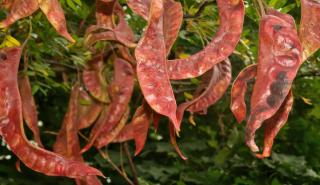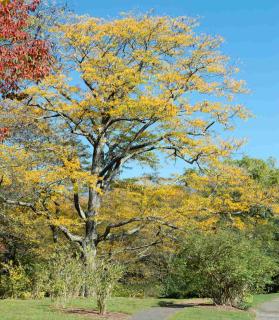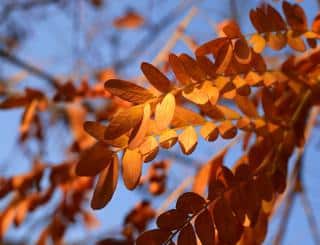

If you’ve got a large garden, go ahead and plant a Gleditsia triacanthos, you’ll savor its cool shade during summer. And, you’ll marvel at the honey locust‘s sweet fall fruit pods in fall and winter.
Gleditsia triacanthos key facts
Botanical name – Gleditsia triacanthos
Family – Fabaceae
Type – tree
Height – up to 90 feet (30 m)
Exposure – sun to part shade
Soil – fertile, well drained
Hardiness – hardy 5 to 23°F (-5 à -15 °C)
Growth – average to fast
Foliage – deciduous
Fruit formation – end of summer, fall
Flowering – beginning of summer (insignificant)
Common names: Honey locust, sweet bean tree, honey shucks locust, thorny locust…
The list says it all: thorns, sweet fruits… an interesting mix!
This tree is native to North America. The plus-sized growth of this tree and its magnificent foliage make this tree a welcome haven of shade to fight off extreme summer heat. The most significant point – literally – of honey locust are the many thorns along the trunk and branches.

The more adventurous among us can even try to ferment it to brew beer.
Leaves of honey locust are somewhat similar to those of black locust. They’re up to 8 inches long (20 cm), with many oval leaflets. When fall comes around, they slowly take on a gold-yellow hue.
Did you know… ? The elegant Gleditsia triacanthos is sometimes also called Thorns of Christ: it’s said that the Crown of thorns that Jesus wore during the passion was wrought from this tree’s branches.

Older trees are hardier and won’t suffer much from the cold, but younger plants aren’t as resistant. In addition, honey locust deals pretty well with drought. As a consequence, the best time to plant your tree is at the beginning of spring. If needed, though, you can still of course plant in fall, but you’ll have to protect the tree during that first winter.
After selecting the right spot, simply:
You can get new thorny locust specimens either through seeds (sow in fall) or by grafting (shield grafting) at the end of summer.
Thorny locust does require a little bit of maintenance during the first few years of growth:
A resilient tree, honey locust isn’t vulnerable to diseases, nor does it fall victim to parasite insects and pests.

It can grow there as a standalone or in a row, alongside a road or walkway.
Since it resists pollution very well, it even serves to decorate streets.